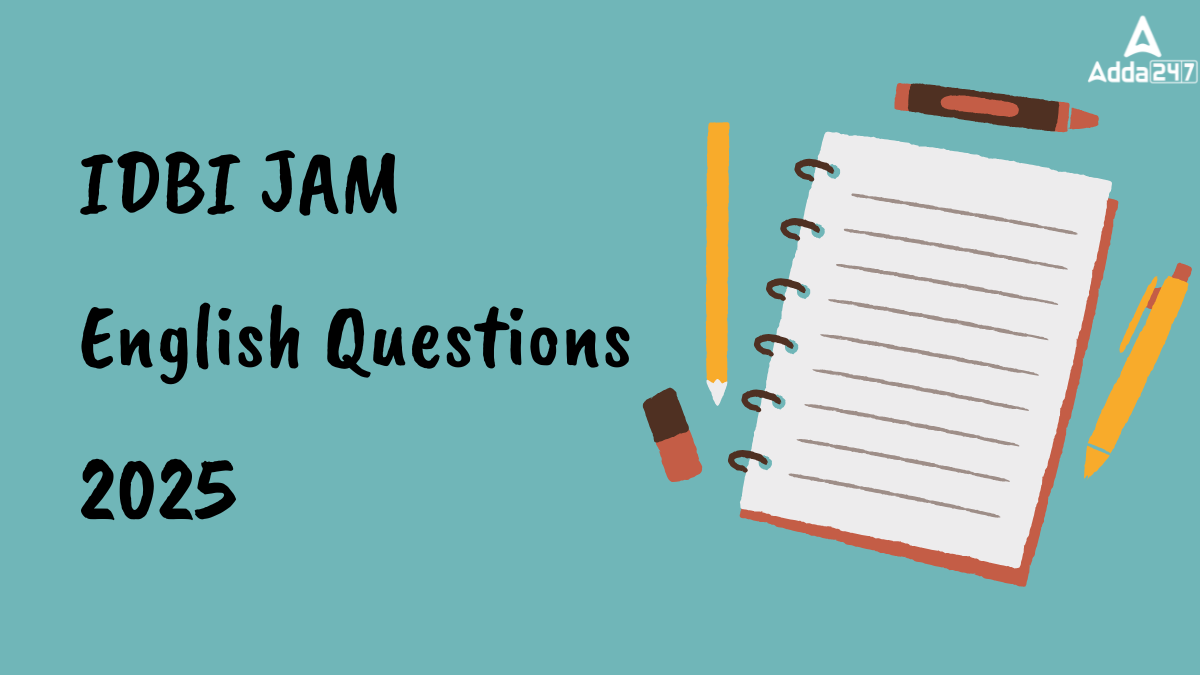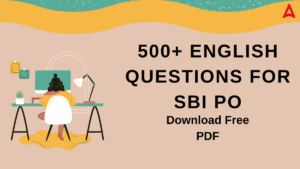The IDBI Junior Assistant Manager (JAM) 2025 exam includes an English Language section that tests candidates’ proficiency in grammar, vocabulary, and comprehension. With increasing competition for banking jobs, mastering this section is crucial to clear the cut-off and secure a position at IDBI Bank. As a public sector bank with growing international operations, IDBI places significant emphasis on candidates’ ability to communicate effectively in English, a skill essential for customer interactions, report writing, and financial documentation.
IDBI JAM English 2025
In today’s competitive banking recruitment landscape, the English Language section of the IDBI JAM Recruitment 2025 exam serves as a crucial differentiator. With the exam pattern evolving to include more context-based questions, candidates must adopt a targeted preparation strategy to excel in this section, which carries 40 marks and influences the overall cutoff. The English component of IDBI JAM 2025 is designed to evaluate functional language skills relevant to banking operations.
IDBI JAM English Questions 2025
Directions (01-07): Read the following passage and answer the questions that follow. Some words in the passage have been highlighted to aid in answering the question.
The philosophy of education is a field of study that seeks to understand the nature, purpose, and methods of education. It involves examining the principles and values that guide educational practices, as well as the social, cultural, and historical contexts in which education occurs. At its core, the philosophy of education is concerned with the question of what it means to be an educated person and how we can foster that development in others. This requires an understanding of the goals and objectives of education, such as the acquisition of knowledge, the development of critical thinking skills, and the cultivation of ethical and moral values.
Moreover, the philosophy of education recognizes that education is not a neutral or value-free enterprise. Rather, it is shaped by the cultural, social, and political contexts in which it occurs. Therefore, it is essential to consider the power dynamics that exist within educational institutions and to critically examine the assumptions and biases that underlie educational practices.
In practice, the philosophy of education is a _________________ and ongoing conversation that involves educators, researchers, policymakers, and other stakeholders. It provides a framework for reflecting on the goals and values of education and for making decisions about how best to achieve those goals. Ultimately, the philosophy of education is an essential component of any effort to improve educational outcomes and to create a more just and equitable society.
Q01. What is the goal of the philosophy of education in promoting fairness and equality through educational practices and principles?
(a) To establish proficient members of the community who can contribute effectively.
(b) To emphasize the importance of personal accomplishment rather than collaborative advancement.
(c) To create a more just and equitable society by advancing impartiality and parity.
(d) To prioritize individual achievement over collaborative progress.
(e) None of the above
Q02. In what capacity does the educator function in the philosophy of education?
(a) As a facilitator of knowledge and learning processes.
(b) As an enforcer of rules and discipline.
(c) As a passive observer of students’ progress.
(d) As a provider of grades and evaluations.
(e) As a promoter of standardized testing.
Q03. In what manner can the philosophy of education influence forthcoming times?
(a) By shaping educational policies and practices to meet the evolving needs of society.
(b) By discouraging critical thinking and creativity in learners, hindering their ability to adapt to future challenges.
(c) By promoting standardized testing as the sole measure of educational success, neglecting other important aspects of learning.
(d) By advocating for a one-size-fits-all approach to education, disregarding individual differences and diverse learning styles.
(e) By prioritizing rote memorization over conceptual understanding and application of knowledge.
Q04. In what manner can the philosophy of education be defined?
(a) A collection of fundamental beliefs and values directing the implementation of education
(b) The spatial configuration of an educational space
(c) The analysis of the past of educational practices
(d) A particular approach to teaching
(e) None of the above.
Q05. Which of the following words is the most similar in its definition as the highlighted word understand, the definition corresponding to its usage in the passage?
(a) penetrate
(b) misinterpret
(c) comprehend
(d) misconstrue
(e) irresistible
Q06. Which of the following words is the most opposite in its definition as the highlighted word enterprise, the definition corresponding to its usage in the passage?
(a) gamble
(b) company
(c) firm
(d) ambition
(e) inertia
Q07. Which of the following fills the highlighted blank in the passage appropriately?
(a) dynamic
(b) frail
(c) effete
(d) impotent
(e) feeble
Directions (08-12): Read the following passage and answer the given questions. Some words are highlighted aid in answering the questions.
Time is a fundamental concept that has been debated by philosophers, scientists, and artists for centuries. In its most basic form, time is defined as a measurement of duration, but it also has complex dimensions that relate to human perception and cultural influences. From the perspective of physics, time is a relative measure of the motion of objects, and it is defined by the interval between two events. However, this objective definition of time is often at odds with the subjective experience of time by human beings.
One of the most significant challenges of understanding time is the perception of time by humans, which can vary based on several factors, including age, mood, and cultural background. For example, a person who is bored may feel that time is passing more slowly than someone who is engaged in an activity they enjoy. Similarly, the perception of time varies across different cultures, with some cultures having a more relaxed attitude towards time, while others place a greater emphasis on punctuality.
In addition to these subjective dimensions, time is also an essential aspect of human culture. The measurement of time has allowed humans to organize their lives and create a sense of order in the world. Time is used to regulate social behaviour, and it is also a critical factor in economic and political systems. The cultural significance of time is evident in the vast number of idioms and expressions that refer to time in different languages, such as “time is money” or “time flies when you’re having fun.”
Overall, time is a complex concept that has both objective and subjective dimensions. The scientific definition of time is based on physical laws and objective measurements, but it is also influenced by cultural and personal factors that can affect human perception of time.
Q08. From the perspective of physics, how is time defined?
(a) Time is a subjective measurement of duration.
(b) Time is an absolute measure of duration.
(c) Time is a relative measure of the motion of objects.
(d) Time is a constant and unchanging dimension.
(e) Time is a function of human perception.
Q09. Which of the following factors can affect human perception of time?
(a) Cultural background and political systems
(b) Mood and level of engagement in an activity
(c) Degree of proficiency in scientific study
(d) Gender and personality traits
(e) All of these
Q10. What is the significance of the measurement of time in human culture?
(a) It has allowed humans to live lives in a more organised manner.
(b) It is a measured very precisely using specified tools and algorithms.
(c) It is irrelevant to social behaviour and administration.
(d) It has no impact on economic and political systems.
(e) It is limited to scientific research and experimentation.
Q11. Which of the following can signify the cultural significance of time according to the passage?
(a) It has no impact on social behaviour or organization.
(b) It is limited to scientific research and experimentation.
(c) Its importance has inspired many expressions in many languages.
(d) It is a function of subjective human perception.
(e) It is used primarily in artistic expression.
Q12. Which of the following is the most appropriate antonym for the word “emphasis” as is highlighted in the passage?
(a) enhancement
(b) disregard
(c) endeavour
(d) sequence
(e) constriction
Directions (13-17): In the following questions two columns are given, each containing three phrases/sentences. Choose the option that will connect the phrases to form meaningful and correct sentences.
Q13. COLUMN (I)
(A) The government has announced
(B) As per recent reports, the economy
(C) Experts are of the opinion that the
COLUMN (II)
(D) government needs to implement immediate measures
(E) is showing signs of a fast recovery
(F) great aspirations in outer space
(a) Only B-E and C-D
(b) Only A-D and C-F
(c) Only B-D and C-E
(d) Only A-F and C-D
(e) None of these
Q14. COLUMN (I)
(A) The police have recently launched a massive
(B) The minister of agriculture has announced
(C) The educational institutions are facing
COLUMN (II)
(D) campaign to curb and prevent cybercrime.
(E) a new policy to determine minimum support price.
(F) protesting against the fees hikes in recent years.
(a) Only A-F and B-E
(b) Only B-E and C-F
(c) Only A-F and C-D
(d) Only B-E and A-D
(e) None of these
Q15. COLUMN (I)
(A) The majestic mountain range stretched as far
(B) In the aftermath of the pandemic
(C) Despite several rounds of negotiations
COLUMN (II)
(D) the two countries failed to reach a resolution on the trade dispute
(E) pang of sadness as she said goodbye to her friend.
(F) so company has decided to relocate its manufacturing facilities.
(a) Only A-D
(b) Only C-D
(c) Only A-F and B-D
(d) Only B-E and A-D
(e) None of these
Q16. COLUMN (I)
(A) Although he had no prior experience in the field
(B) The athlete trained tirelessly to prepare for the
(C) The children giggled as they played in the
COLUMN (II)
(D) the company’s stock price continued to plummet
(E) many investors are bullish on the prospects of the tech sector
(F) he managed to turn the company around in just a year
(a) Only A-D
(b) Only A-D and C-E
(c) Only A-F
(d) Only B-D and C-F
(e) None of these
Q17. COLUMN (I)
(A) Despite the mountains in the distance looked majestic
(B) I have to wake up early tomorrow for
(C) The policy makers’ decision to hike taxes
COLUMN (II)
(D) many consumers continue to remain loyal to the brand
(E) the company has decided to launch a new product line
(F) has drawn criticism from several quarters.
(a) Only B-E
(b) Only B-E and C-F
(c) Only A-F and B-D
(d) Only C-F
(e) None of these
Directions (18-22): In each of the questions given below four words are given in bold. These five words may or may not be in their correct position. The sentence is then followed by options with the correct combination of words that should interchange with each other in order to make the sentence grammatically and contextually correct. Find the correct combination of the words that replace each other.
Q18. The idea of mindfulness has become increasingly popular (A) among people seeking (B) to improve (C) stress and reduce (D) their well-being.
(a) B-A
(b) A-D and B-C
(c) D-C
(d) B-C
(e) No interchange required
Q19. The team’s opponents (A) in the championship were ultimately unsuccessful (B) as they lost the final (C) game to their efforts (D).
(a) B-C
(b) D-C
(c) A-D and B-C
(d) A-D
(e) No interchange required
Q20. She had to decided (A) between helping (B) to the party or going (C) out her parents, but she ultimately choose (D) on the former.
(a) A-C
(b) A-D and B-C
(c) B-C
(d) A-D
(e) No interchange required
Q21. Kerala easing (A) some of the relaxations(B) it had granted(C) earlier today, in line with the staggered revoked (D) of lockdown,
(a) (A) – (B)
(b) (B) – (C)
(c) (A) – (D)
(d) (A) – (D) and (B) and (C)
(e) No interchange required
Q22. Vijay Mallya had against (A) to the High Court appealed (B) his extradition to India at a this (C) in February hearing (D) year.
(a) (A) – (D)
(b) (B) – (C)
(c) (A) – (B)
(d) (C) – (D) and (B) and (A)
(e) No interchange required
Directions (23-25): A word has been given in each question and used in the sentences given below. Identify the statements where the word has been used in a contextually and grammatically correct manner. If the word has been used incorrectly in all the statements, mark “None of these”, as your answer.
Q23. Consistent
(i) The consistent models of economic growth have led to unsustainable patterns of natural resource exploitation.
(ii) She’s one of the team’s most consistent players.
(iii) There is consistent evidence of climate change deriving from socially constructed vulnerabilities.
(a) Only (i)
(b) Only (ii)
(c) Both (ii) and (i)
(d) Both (ii) and (iii)
(e) None of these
Q24. Vulnerable
(i) The Mahanadi delta is among the most vulnerable deltas in the world.
(ii) In the study, villagers reported issues of vulnerable agricultural production.
(iii) Collaboration between groups that is vulnerable to both parties should be promoted.
(a) Only (i)
(b) Only (ii)
(c) Both (ii) and (i)
(d) Both (ii) and (iii)
(e) None of these
Q25. Prominent
(i) Water availability and quality have been one of the most prominent issues.
(ii) Development plans have increasingly diverted water to industrial areas at the prominent of rural communities.
(iii) The gender gap in education is less prominent in the delta region than in other areas of Odisha.
(a) Only (i)
(b) Only (ii)
(c) Both (iii) and (i)
(d) Both (ii) and (iii)
(e) None of these
| Answers | |||||||||
| 1 | c | 2 | a | 3 | a | 4 | a | 5 | c |
| 6 | e | 7 | a | 8 | c | 9 | b | 10 | a |
| 11 | c | 12 | b | 13 | a | 14 | d | 15 | b |
| 16 | c | 17 | d | 18 | c | 19 | d | 20 | b |
| 21 | c | 22 | d | 23 | d | 24 | c | 25 | c |




 English Questions for SBI Clerk Mains 20...
English Questions for SBI Clerk Mains 20...
 Top 50+ Error Detection Questions for SB...
Top 50+ Error Detection Questions for SB...
 500+ English Questions for SBI PO 2025, ...
500+ English Questions for SBI PO 2025, ...








